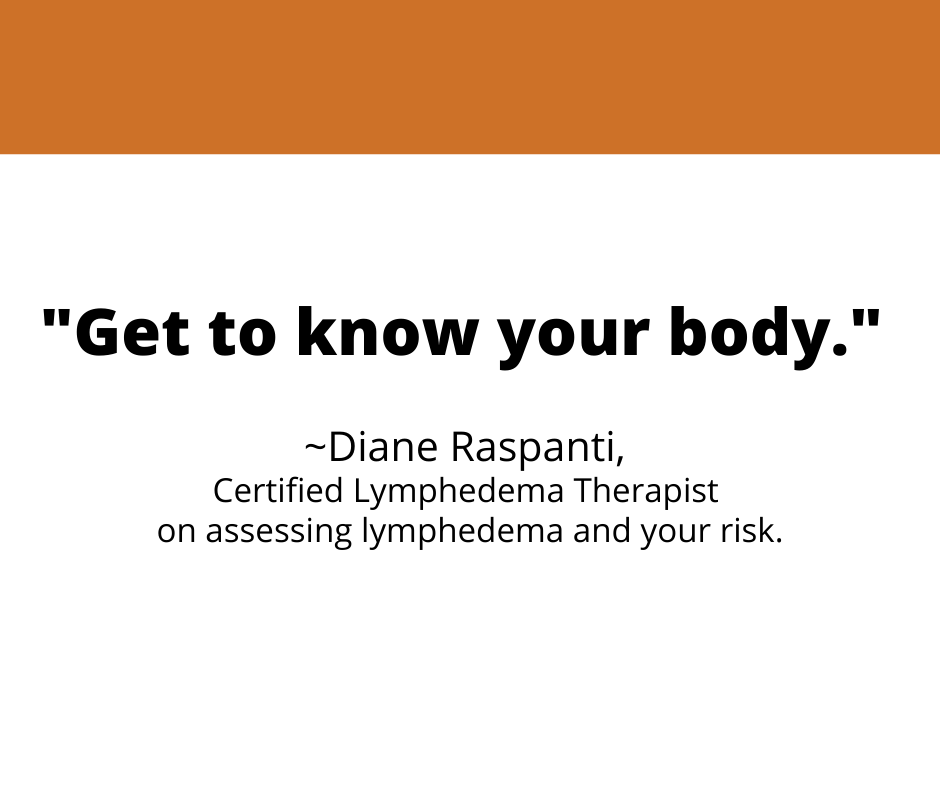Preventing, Identifying, and Living With Lymphedema
November 2, 2021
Lymphedema can be one of the most dominant fears and disheartening effects of breast cancer treatment. Patients often spend years living in fear of developing this type of permanent swelling in an area where they underwent lymph node dissection.
Fortunately, advances in treatment and an improved understanding of prevention mean that the condition is less daunting than it once was. Manual Lymphatic Drainage Massage expert Diane Raspanti joined us for a Be Informed Lecture on how lymphedema develops along with prevention and treatment options.
Read on for highlights, or watch the whole session, here!
Lymphedema does not just have to be in the arm: it can affect other areas of the body.
Lymphedema can develop in the affected breast, the trunk, the chest wall, and in the entire radiation field in patients who have undergone radiation. The best way to determine whether it has begun to develop for you is to be vigilant in assessing your body. Ask yourself whether your breasts look different, whether your bras are fitting consistently, and whether areas of your body feel heavier or take on more marks.
“‘Get to know your body’ is my biggest statement,” Raspanti said.
The condition usually arrives sooner rather than later.
“Most of the time if you’re going to get lymphedema, it’s going to happen in the first 1-2 years, but it can happen later,” Raspanti said.
While it can happen in the years that follow, knowing the signs of lymphedema can prevent undue stress. One key feature is that it tends to develop slowly over time. According to Raspanti, it usually starts with the hand or wrist and then slowly works its way up the arm. There’s a 30% increase in the lymphatic fluid in the arm before you can even see a difference.
“If your arm starts to swell rather quickly, that’s not lymphedema. That’s something that needs to be addressed immediately, but it’s not lymphedema,” she said.
Limb fatigue is one of the most common signs of lymphedema.
She said the main complaint she receives from patients is that at the end of the day the arm is tired or that there’s an overall achiness to the arm. She said it’s also important to note new discomfort, like tightness in the hand.
Prevention focuses on reducing pressure to the arm without hampering your life.
Raspanti saided that patients should avoid having blood drawn or blood pressure measured using the affected arm because they both apply substantial external pressure. Older wisdom also advised patients to avoid heavy lifting and certain types of activities, but Raspanti explained that those limitations were not necessary: “We want you to continue your active lifestyle, we just want you to take breaks.”
Manual Lymphatic Drainage Massage can provide relief and restoration for patients with lymphedema.
This specific type of massage—which requires specialized training—is designed to help move lymphatic fluid throughout the body. It can help redistribute the edema a patient has developed in a specific area.
“It is not a treatment you should be afraid of, because you are coming into a treatment room, laying down, and getting a very gentle massage. The whole goal of the massage is to increase the circulation of the lymphatic system throughout the whole body,” she said.
It is essential for compression garments to fit properly.
Simply put, an improperly fitted compression sleeve can be more damaging than no sleeve at all. Raspanti stressed the importance of going to a professional to acquire a custom fitted garment, lest you risk worsening the situation. She also emphasized the fact that even a properly fitted device should never be worn while sleeping.
Kinesio tape can help improve drainage in areas that are hard to compress or bandage, like the breast or trunk.
Raspanti said that therapists take a piece of the kinesio tape and cut it to look like an octopus. They apply that tape to the body to direct the flow of fluid. “What the tape does is totally opposite of what we think the compression does. It gives the lymphatic fluid channels to move away from the edema.”
While lymphedema cannot be cured, prompt treatment can substantially restore the affected area.
“We can never say we’ve cured you of lymphedema. That said, if you catch the lymphedema when it’s very mild and there hasn’t been tissue damage, you can really get the swelling down and maintain it and manage it to where it’s near normal,” Raspanti said.
Breast Cancer Awareness Month: Sharsheret event
Dr. Randall Feingold delved into the importance of breast cancer awareness, screening and detection at an event hosted by Sharsheret as part of Breast Cancer…
